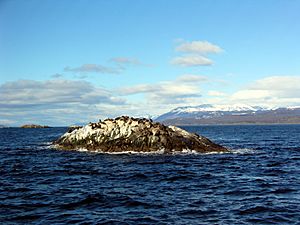Salt water facts for kids
Saline water is just a fancy name for water that has a lot of salt dissolved in it. You probably know it best as the water found in our huge seas and oceans. In fact, most of the water on Earth is salty!
You might hear saline water called salt water or saltwater. It's very different from the fresh water we drink.
Contents
What is Salinity?
When scientists talk about how much salt is in water, they use the word salinity. Salinity tells us how salty the water is. They measure salinity in "parts per thousand" or "ppt." This means how many parts of salt there are for every thousand parts of water.
Most ocean water has about 35 ppt salt. This means for every 1,000 grams of seawater, about 35 grams are salt. Some Salt lakes can be much saltier, even ten times more salty than the ocean! If water gets too salty, the salt can start to form a salt plain on the ground.
Different Types of Salty Water
- Sea water is the water found in oceans and seas. It has an average salinity of about 35 ppt.
- Brine is water that is much saltier than sea water. People often use brine to help preserve food, like pickling vegetables.
- Brackish water is water that is less salty than sea water, but still saltier than fresh water. You might find brackish water where a river meets the ocean, like in an estuary.
Why is Salty Water Different?
Salty water is heavier than fresh water. Scientists say it is more dense. Density means how much "stuff" is packed into a certain amount of space.
Fresh water has a density of 1 gram per milliliter (g/ml). This means 1 milliliter of fresh water weighs 1 gram. Salty sea water is a bit heavier. It has an average density of about 1.025 g/ml. This is why it's easier to float in the ocean than in a freshwater lake!
Is it Safe to Drink Salty Water?
Drinking sea water is not good for your body. Our bodies need fresh water to stay healthy. If you drink salty water, your body has to work very hard to get rid of the extra salt. This can make you even more thirsty and can be dangerous.
Related pages
Images for kids
See also
 In Spanish: Agua de mar para niños
In Spanish: Agua de mar para niños



